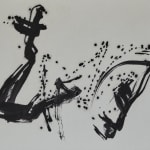Morita Shiryū (1912–1998)
Asa
Ink on paper, framed
c. 1970
With a label signed by Inada Sousai
69 x 92 cm
71 x 94 cm (overall)
c. 1970
With a label signed by Inada Sousai
69 x 92 cm
71 x 94 cm (overall)
Literature
Morita Shiryu Catalogue Raisonné: 1952–1998. Uji: Soryusha, 2019.
In the latter half of 1960s, Morita was no longer satisfied with Zen philosophy, its emphasis on the concept of nothingness and the idea of the self that derived thereof. At this point, he thought to reorient himself by returning to the practice of rinsho, an East Asian practice of copying calligraphic masterpieces for the sake of study. In rediscovering the classics and the world of the masters of the past, Morita sought to strengthen the connection of the self with the experience of the exterior world. This way, a practitioner would aim to align themselves with the natural flow of energy (ki, also: spirit; natural disposition), an approach that is related to fellow calligrapher Hidai Tenrai’s notion of koho (studying the ways of the ancients) and ri ([understanding the] underlying universal principle).
In Morita’s interpretation, there is yet another layer of meaning to rinsho and the classics. Through the practice, one is able to understand of how the ink (material) and the brush (artist himself) interact on the paper (a finite universe), as well as of how the nature functions and how the things act in a broader sense. In this work, Morita let the ink follow the rule of nature to scatter on the paper by chance, seeking to find out the resonance between the inner self and the outer thing.
In Asa, the artist begins with a sudden strong vertical brushstroke that creates the so-called “flying white” dry-brush effect (white paper ground showing through the ink); the next moment ink drips in accordance with the movement of the brush in a slow rhythm that harmonizes the entire space in a lyrical atmosphere. Allowing for randomness and following nature’s flow when applying the ink on the paper balances the self and the exterior world to a new unison.
Morita Shiryu (avant-garde calligrapher; 1912–1998)
Avant-garde calligrapher from Hyogo Prefecture. Like fellow artist Inoue Yuichi, Morita studied under the calligraphy master Ueda Sokyu. He co-founded the avant-garde group Bokujinkai together with Inoue and was the founder and editor of the journal Bokubi (Beauty of Ink), both of which revolutionized traditional Japanese calligraphy and spread knowledge of Japanese avant-garde calligraphy to an international audience. He was posthumously awarded the Medal of Honor with Dark Blue Ribbon.
In Morita’s interpretation, there is yet another layer of meaning to rinsho and the classics. Through the practice, one is able to understand of how the ink (material) and the brush (artist himself) interact on the paper (a finite universe), as well as of how the nature functions and how the things act in a broader sense. In this work, Morita let the ink follow the rule of nature to scatter on the paper by chance, seeking to find out the resonance between the inner self and the outer thing.
In Asa, the artist begins with a sudden strong vertical brushstroke that creates the so-called “flying white” dry-brush effect (white paper ground showing through the ink); the next moment ink drips in accordance with the movement of the brush in a slow rhythm that harmonizes the entire space in a lyrical atmosphere. Allowing for randomness and following nature’s flow when applying the ink on the paper balances the self and the exterior world to a new unison.
Morita Shiryu (avant-garde calligrapher; 1912–1998)
Avant-garde calligrapher from Hyogo Prefecture. Like fellow artist Inoue Yuichi, Morita studied under the calligraphy master Ueda Sokyu. He co-founded the avant-garde group Bokujinkai together with Inoue and was the founder and editor of the journal Bokubi (Beauty of Ink), both of which revolutionized traditional Japanese calligraphy and spread knowledge of Japanese avant-garde calligraphy to an international audience. He was posthumously awarded the Medal of Honor with Dark Blue Ribbon.



